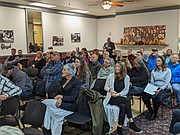Wallace hosts Gov. Little’s ‘Capital for a Day’ event
WALLACE — County seat, Center of the Universe, and now the capital of Idaho. The list of Wallace’s titles seems to have no bounds.
The historic Shoshone County town was the latest in the state to be selected by Gov. Brad Little’s Office to host the long running “Capital for a Day” program. Every month, the governor, along with numerous members of his cabinet, visits a rural community in Idaho to provide residents with the opportunity to address their issues for an entire day.
Hosted at the Wallace Elks Lodge No. 331, the banquet hall was packed throughout the day with concerned citizens, curious observers, and even inquisitive youngsters.
Groups of students from Wallace Jr./Sr. High School cycled through the building throughout the day and posed their own questions to the available officials.
From 10 a.m. to 3 p.m., the governor and his cabinet fielded a variety of questions regarding a wide range of subjects. From hyperlocal topics such as superfund designations, lake health and Kootenai Health to state topics such as lack of affordable housing, COVID regulations, the drug crisis and education funding — attendees certainly kept the visiting state officials on their toes.
Officials that accompanied the governor Thursday included:
• Idaho State Controller Brandon Woolf
• Idaho Department of Commerce Marketing and Innovation Administrator Matt Borud
• Idaho Department of Environmental Quality Director Jess Byrne
• Idaho Department of Financial Management Administrator Alex Adams
• Idaho Department of Health and Welfare Director Dave Jeppesen
• Idaho Department of Fish and Game Director Ed Schriever
• Idaho Department of Labor Director Jani Revier
• Idaho Department of Lands Director Dustin Miller
• Idaho Department of Parks and Recreation Director Susan Buxton
• Idaho State Department of Agriculture Division of Plant Industries Administrator Lloyd Knight
• Idaho Transportation Department Director Scott Stokes
• Idaho State Police District 1 Captain John Kempf/Lt. Col Sheldon Kelley
Regarding the efforts being done to treat and rehabilitate Lake Coeur d’Alene following years of mining pollution being washed into it from the Silver Valley, both Little and IDEQ Director Jess Byrne said that while there is a long way to go, progress is being made — especially now that the Coeur d’Alene Tribe has once again agreed to work with them.
“There’s no magic bullet to take care of all those heavy metals that, for years, have flowed down into Lake Coeur d’Alene,” Little said.
Byrne added, “We are right now having conversations about what additional monitoring might look like and how much that would cost. The governor, through his Leading Idaho initiative, put $22 million towards nutrient reduction projects around Lake Coeur d’Alene.”
Byrne explained that the reason for the nutrient reduction efforts is to maintain a level of oxygen at the bottom of the lake. This layer of oxygen plays a big role in keeping the mine waste at the bottom of the lake.
“The goal, at least for now, is that we can’t get those minerals out of the bottom of that lake, so we want to make sure that they stay where they are, for right now,” Little said.
Currently, IDEQ has $8 million worth of projects identified to rehabilitate the lake.
When asked about the current situation involving North Idaho College’s leadership and accreditation situation, Little stressed how important community colleges are to Idaho communities (especially for those just getting out of high school) and those communities have a voice.
“The community has ownership in this. Elections have consequences.”
Many of the questions from the day carried the consistent theme of growth in Idaho. To end the event, each official took a moment to speak on what challenges their departments are currently facing due to the rapid population growth in Idaho and what they are doing to address it.
“Everybody around this table tries to do all they can to help local government and help you make a decision,” Little said.
Speaking of consistent themes, many of the officials spoke of employee shortages in their departments and how that can make accommodating growth difficult.
Department of Parks and Recreation Director Susan Buxton explained that Parks and & Recreation has seen a 30% increase since the COVID-19 pandemic.
“What we’ve done to address this, with some help from the division of financial management, the governor and the legislature, we’ve secured some extra funds in our budget and some ARPA funds…We will be adding approximately 250 campsites, 150 docks/boat slips, and 25 day-use areas in the next 4-5 years.”
Department of Lands Director Dustin Miller added to this point, as his department is seeing more and more people move into rural areas, which may rub up against the endowment lands that they manage.
“We protect 6.2 million acres from wildfire. We have a big wildland firefighting force, but it's becoming more of a challenge to protect those areas because people are moving into those places that are more at risk.”
Jani Revier with the Department of Labor spoke of doing everything they can to assist in alleviating the workforce shortage, such as encouraging people to come back into the workforce and provide opportunities to get people the training they need.
Commerce Marketing and Innovation Administrator Matt Borud talked about how his department thinks about growth conceptually between growth versus change.
“We all see more people here, but we’re also seeing fundamental changes in how we live, how we work, how we play, how we recreate — all those things.”
He added that in order to continue to promote new and exciting businesses in Idaho, they will have to adapt to this new change.



